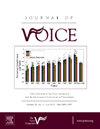促进教师嗓音健康的移动医疗 "健康与嗓音 "的可用性和可接受性。
IF 2.5
4区 医学
Q1 AUDIOLOGY & SPEECH-LANGUAGE PATHOLOGY
引用次数: 0
摘要
目的评估 "健康与嗓音 "在促进嗓音健康方面的可用性和可接受性,并结合社会人口学数据、工作数据以及小学教师对嗓音保健、嗓音劣势和嗓音疲劳症状的自我认知数据进行分析:横断面观察研究,样本为巴西首都的 277 名小学教师。教师们受邀访问、互动并评估移动医疗系统 "健康与嗓音":"健康与声音"。评估工具包括包含社会人口和工作数据信息的问卷、系统可用性量表(SUS)、包含可接受性问题的问卷、嗓音障碍指数协议(VHI-10)和嗓音疲劳指数协议(VFI)。通过卡方检验、费雪精确检验、曼-惠特尼检验和威尔科克森检验(P ≤ 0.05)进行了描述性分析和关联分析 结果:SUS 的平均得分是 81.9 分;接受度问题的平均得分是 17.24 分;VHI-10 的平均得分是 6.96 分;VFI 的平均得分是 21.11 分。大多数参与者对移动医疗的可接受性评价较高。可接受性与两班倒之间存在关联(P = 0.019);可接受性与可用性之间存在关联(P < 0.001);可用性与使用移动医疗后对语音护理知识的自我认知之间存在关联(P = 0.000)。认为最重要的活动是嗓音保健指导:结论:"健康与嗓音 "是一款面向教师的嗓音指导工具,旨在促进嗓音健康。结论:"健康与嗓音 "是一款面向教师的嗓音指导工具,旨在促进嗓音健康。使用 "健康与嗓音 "后,教师自我报告的嗓音保健知识有所增加,对该技术的接受度高的教师将其归类为可用性高的可能性增加了 3.6 倍。本文章由计算机程序翻译,如有差异,请以英文原文为准。
The Usability and Acceptability of the mHealth “Health and Voice” for Promoting Teachers' Vocal Health
Objective
To evaluate the usability and acceptability of “Health and Voice” for the promotion of vocal health, and to analyze the same with sociodemographic data, work data, self-knowledge data on vocal care, voice disadvantage, and vocal fatigue symptoms in elementary school teachers.
Material and methods
A cross-sectional observational study, with a sample of 277 elementary school teachers from a Brazilian capital. Teachers were invited to access, interact and evaluate the mHealth: “Health and Voice”. The evaluation instruments were the questionnaire with information on socio-demographic and work data, the System Usability Scale (SUS), the questionnaire with questions about acceptability, the Voice Handicap Index Protocol (VHI-10), and the Vocal Fatigue Index Protocol (VFI). Descriptive and association analyses were performed by the Chi-square, Fisher exact, Mann-Whitney, and Wilcoxon tests (P ≤ 0.05)
Results
the mean SUS score was 81.9 points; the mean of the acceptability questions was 17.24; the VHI-10 was 6.96 points; the VFI was 21.11 points. Most participants rated the acceptability of mHealth as high. There was an association between acceptability and working in two shifts (P = 0.019); between acceptability and usability (P < 0.001); and between usability and self-perception of knowledge about voice care after using mHealth (P = 0.000). The activity perceived as most important was guidance on voice care.
Conclusion
“Health and Voice” is a vocal guidance tool for teachers that promotes vocal health. It has high usability and acceptability by elementary school teachers. Self-reported knowledge about vocal care increases after its use and those who evaluate the technology with high acceptability are 3.6 times more likely to also classify it with high usability.
求助全文
通过发布文献求助,成功后即可免费获取论文全文。
去求助
来源期刊

Journal of Voice
医学-耳鼻喉科学
CiteScore
4.00
自引率
13.60%
发文量
395
审稿时长
59 days
期刊介绍:
The Journal of Voice is widely regarded as the world''s premiere journal for voice medicine and research. This peer-reviewed publication is listed in Index Medicus and is indexed by the Institute for Scientific Information. The journal contains articles written by experts throughout the world on all topics in voice sciences, voice medicine and surgery, and speech-language pathologists'' management of voice-related problems. The journal includes clinical articles, clinical research, and laboratory research. Members of the Foundation receive the journal as a benefit of membership.
 求助内容:
求助内容: 应助结果提醒方式:
应助结果提醒方式:


